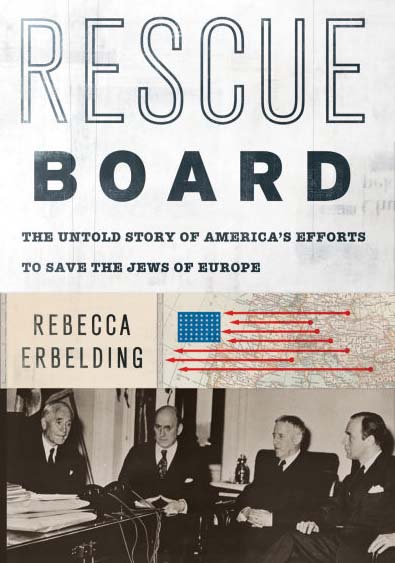
New Book on War Refugee Board
U.S. endeavor to assist persecuted Jews during the Holocaust
While American response to the Holocaust has long been debated by historians and the general public, the history of the War Refugee Board (WRB), which was set up by President Franklin D. Roosevelt in January 1944 and whose purpose was to save the remainder of Europe’s Jews, has remained little known. Rescue Board: The Untold Story of America’s Efforts to Save the Jews of Europe, Rebecca Erbelding’s fast-paced, well-written book fills the gap.
Dr. Erbelding, an archivist, curator and historian at the United States Holocaust Memorial Museum, who conducted extensive research in the JDC Archives, starts the book by providing the background to the War Refugee Board. The WRB came at the initiative U.S Treasury Department staff members, who had grown increasingly frustrated by the obstructions placed by the State Department in regard to providing aid to the Jews of Europe. In the summer of 1943, the Treasury Department approved a license to the World Jewish Congress to fund the relief of Nazi victims in Europe but the State Department deliberated delayed the plan. Additionally, in December 1943, Treasury staff found evidence that State officials had suppressed information received about the mass murder of Jews. Exasperated, Treasury Secretary Henry Morgenthau, Foreign Funds Control Director John Pehle, and General Counsel Randolph Paul convinced President Roosevelt of the need to set up a special agency to oversee refugee relief.
The War Refugee Board was established through an executive order of President Roosevelt on January 22, 1944. Erbelding points out that, “for the first time, an Allied country had an official government policy to save the Jews.” While the WRB was officially overseen by the Secretaries of State, War, and Treasury, it was led by Executive Director John Pehle and staffed by other Treasury staff members who had lobbied for its establishment and were deeply committed to its mission.
As the WRB had no background in relief work, no personnel in occupied territories, and no idea how to allocate the funds, Pehle turned to JDC and other relief agencies, including the Quakers. These groups already had extensive networks and ongoing projects in Europe, and the WRB staffers would act as “red-tape cutters,” making sure that nothing got in the way of their relief work. The relationship between JDC and the WRB was particularly close. According to Erbelding, Pehle trusted JDC Secretary, Moses Leavitt “explicitly” and even asked him to teach him a crash course on relief work. In addition, Hebert Katzki, who had been a JDC executive in Europe, was brought in as WRB representative in Turkey to bring relief experience to WRB’s work in the area.
Countering the commonly held view that the WRB did too little and too late, Erbelding argues that the War Refugee Board tried everything in its power to prevent atrocities and rescue potential victims. The WRB helped relief agencies, such as the JDC, send money, which was used for food, clothing, medicine, etc. In addition, it arranged for the evacuation of about 8,000 Romanian Jews to Palestine via Turkey between 1944 and 1945, largely financed by JDC. The WRB also played a key role in establishing a refugee camp at Fort Ontario in Oswego, New York. A large portion of the WRB rescue activities took place in Hungary, where it launched a psychological warfare effort, sending messages into enemy territory that warned of postwar Allied retribution against collaborators. The WRB also used funds from the JDC to finance the activities of Swedish businessman Raoul Wallenberg, who provided shelter to thousands of Jews in Budapest. Finally, in the last months of the war, the WRB organized the purchase and delivery of care packages to prisoners in German concentration camps also largely funded by JDC.
The War Refugee Board was shut down by President Truman in September 1945 with the end of the war. In her conclusion, Erbelding notes that the agency’s importance cannot only be measured in the number of people it saved, as much of its work – such as the psychological warfare – was intangible.
Dr. Erbelding recently gave a very well-received public lecture at the JDC on “The US War Refugee Board and JDC,” further exploring the relationship between the two entities.
For more information and a selection of primary-source documents, see the JDC Archives topic guide “JDC and the U.S. War Refugee Board (1944-1945).”



